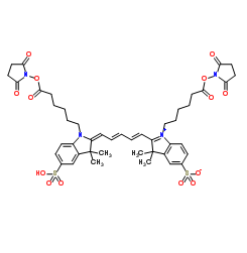文献:In-situ observation of spatial organization of natural rubber latex particles and exploring the relationship between particle size and mechanical properties of natural rubber
文献链接:https://www.sciencedirect.com/science/article/abs/pii/S0926669022002205
作者:Yan-Chan Wei, Ding Zhu, Wen-Yi Xie, Jie-Hui Xia, Meng-Fan He, Shuangquan Liao
相关产品:Cy5
原文摘要:
Natural rubber (NR), an important source of elastomeric material, has superior comprehensive properties compared to synthetic high cis-1, 4-polyisoprene, which are attributed to its peculiar architecture. However, it is a challenge to identify the precise structure of NR, especially the structure of NR particles, as there are no direct characterization methods to perform in-situ investigation of structure of NR particles at an intact state. In this study, we used cryogenic transmission electron microscopy (cryo-TEM) to directly explore the morphology of NR particles existing in the latex without drying or chemical fixation. Then, the spatial organization of proteins and phospholipids on the surface of NR particles was visualized by stochastic optical reconstruction microscopy (STORM). The results show that NR particles are spherical particles with an average particle size of 88 ± 15 nm, and the exterior of NR particles is a mixed monolayer of proteins and phospholipids (ca. 4.6 ± 0.77 nm in thickness). Thus, a more complete model for the Hevea brasiliensis rubber particles was proposed. Moreover, we explicated the relationship between the particle size of NR particles, molecular characteristics, and mechanical properties of NR. The Mn and Mw of small rubber particles (SRPs) with a particle size of 106 nm are (1.56 ± 0.06) × 106 g/mol and (2.21 ± 0.07) × 106 g/mol respectively, which are much larger than those of the large rubber particles (LRPs) with a particle size of 628 nm (Mn: (0.41 ± 0.05) × 10 6 g/mol; Mw: (1.63 ± 0.10) × 106 g/mol). After vulcanization, the SRPs have better mechanical properties. Compared with LRPs, SRPs exhibit a 4.3-fold increase in tensile strength (from 5.7 to 24.6 MPa) and a 3.5-fold increase in toughness (from 12.9 to 44.9 kJ/m2). This work not only provides rational design for the new biomimetic synthetic rubber with unique hierarchical structures and excellent properties, but also offers a new possibility for tuning the mechanical properties of NR by preparation of LRPs/SRPs blend of various ratios.
Cy5:一种荧光染料,属于花菁染料(Cyanine Dyes)家族。它的化学名称是吲哚菁绿(Indocyanine Green)类似物,具有近红外(NIR)荧光特性。其最大吸收波长约为 649nm,最大发射波长约为 670nm。这种近红外波段的荧光在生物成像等领域具有明显优势,因为生物组织在这个波段的自发荧光较低,背景干扰相对较小,从而能够提供更高的成像对比度。基于Cy5的相关性能,介绍如下:

图:Cy5结构式
若天然橡胶胶乳颗粒表面有合适的官能团,例如氨基、羧基等,可以通过化学反应将 Cy5 直接连接到颗粒表面。这种方法标记比较牢固,但需要颗粒表面有特定的反应性官能团。
若没有合适的官能团,可以利用一些中间连接分子。比如先将生物素(biotin)连接到天然橡胶胶乳颗粒表面,然后利用抗生物素蛋白- Cy5 复合物(streptavidin - Cy5)与之结合。因为抗生物素蛋白与生物素之间有高的亲和力,这样就可以将 Cy5 间接标记到颗粒上。
在普通荧光显微镜下,用能够激发 Cy5 的激光照射标记后的天然橡胶胶乳颗粒。通过观察荧光的分布,可以了解颗粒在二维平面上的分布情况。共聚焦显微镜能够对样品进行三维成像。通过对标记有 Cy5 的天然橡胶胶乳颗粒进行逐层扫描,可以构建出颗粒在三维空间中的组织情况。这对于研究胶乳颗粒在复杂体系(如含有其他添加剂的胶乳体系)中的分布有用。
与其他技术联用:可以将 Cy5 标记与动态光散射(DLS)等技术结合。DLS 主要用于测量颗粒的粒径和粒径分布,而 Cy5 标记后的荧光观察可以提供颗粒的空间分布信息。
结论:
该文献使用低温透射电子显微镜 (cryo-TEM) 直接探索存在于胶乳中的 NR 颗粒的形态,使用Cy5进行了标记。不仅为新型仿生学提供了合理的设计合成橡胶具有层次结构和良好的性能,同时也为通过制备各种比例的 LRPs/SRPs 共混物来调整 NR 的力学性能提供了新的可能性。Cy5 在成像方面展示出良好的标记性能。

 2025-08-21 作者:ws 来源:
2025-08-21 作者:ws 来源:

